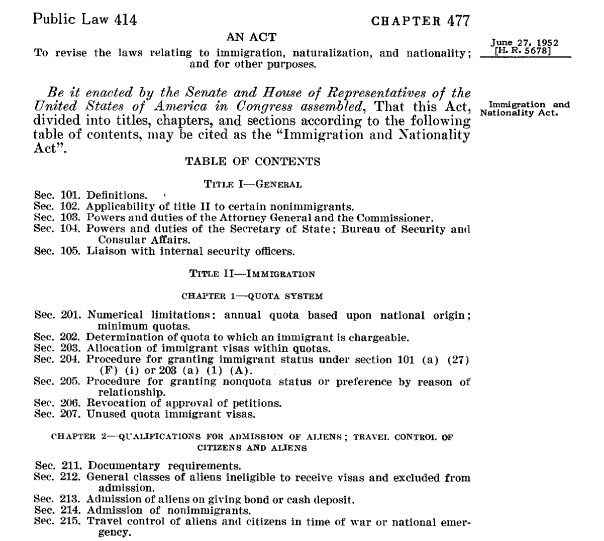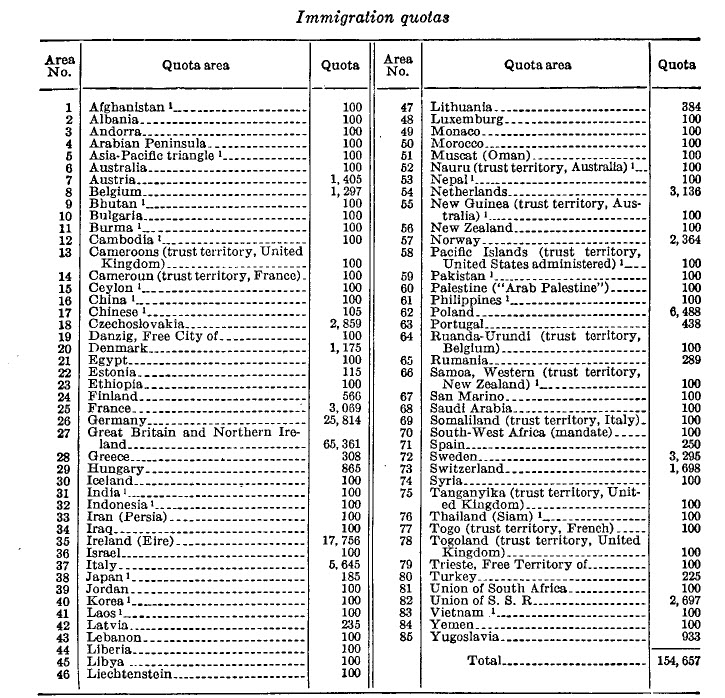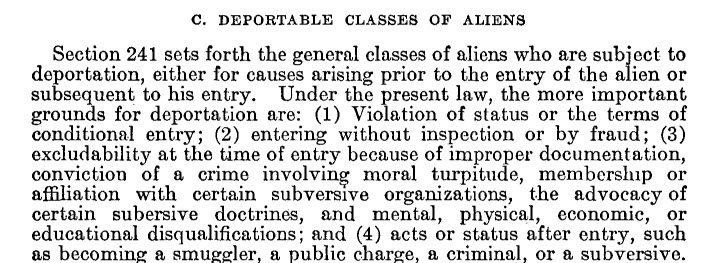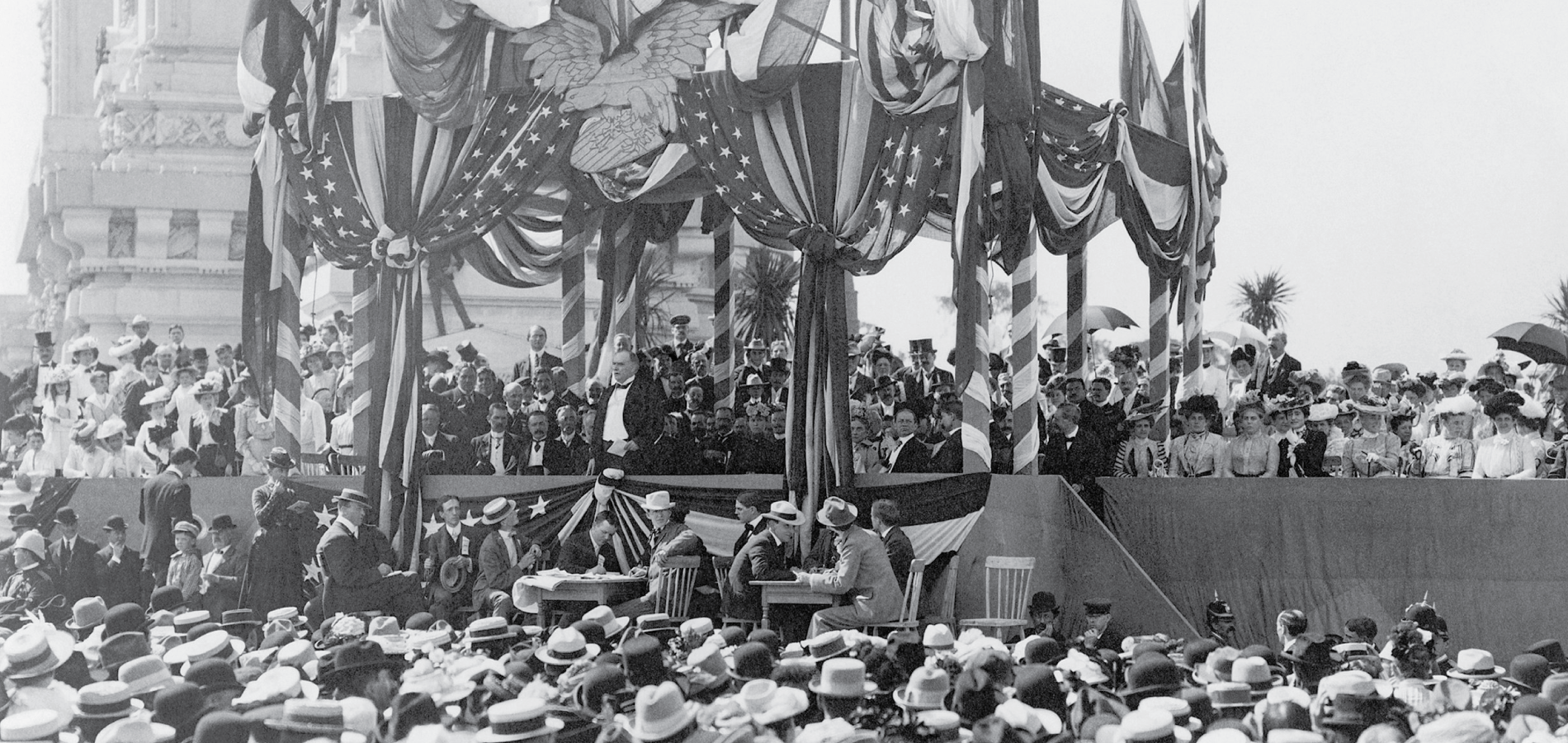Before 1952, U.S. immigration policy was haphazard—many laws existed, but they weren’t consolidated in one place. The laws that did exist were based on highly discriminatory quotas, particularly limiting Asian-Americans. The Immigration and Nationality Act of 1952[1]To revise the laws relating to immigration, naturalization, and nationality, and for other purposes., Public Law 82-414 / Chapter 477, 82 Congress. 66 Stat. 163 (1952) (1952). This act can be found in HeinOnline’s U.S. Statutes at Large … Continue reading solved the first problem, by creating a comprehensive statute of immigration policy,[2]“Review of Republican accomplishments in 82d Congress.” U.S. Congressional Serial Set, , 1952, p. I-26. HeinOnline, https://heinonline.org/HOL/P?h=hein.usccsset/usconset22750&i=1445. This document can be found in … Continue reading but it was still based on quotas and didn’t do much to diversify America’s demographics—this wouldn’t happen until a revisionary law in 1965. In this month’s edition of Secrets of the Serial Set, we explore these laws and how they impacted what America looks like.
Cold War Paranoia
After World War II, the fear of communism and of the infiltration of Soviet spies into American society drove the country into a paranoia. Senator Joseph McCarthy (R-Wisconsin)[3]“U.S. Senate election, expulsion and censure cases, 1793-1990.” U.S. Congressional Serial Set, , 1994, pp. [iii]-486. HeinOnline, https://heinonline.org/HOL/P?h=hein.usccsset/usconset14216&i=428. This document can be … Continue reading accused hundreds of prominent Americans of having communist sympathies, leading to the Red Scare. The idea that national security was at risk struck fear into the hearts of many Americans—including those in charge of determining which immigrants were allowed to come to America and become citizens.
Senator Pat McCarran (D-Nevada),[4]“Statue proceedings for Patrick A. McCarran of Nevada.” U.S. Congressional Serial Set, , 1959, pp. i-74. HeinOnline, https://heinonline.org/HOL/P?h=hein.usccsset/usconset22275&i=632. This document can be found in … Continue reading chairman of the Senate Judiciary Committee, and Representative Francis E. Walter (D-Pennsylvania)[5]“Immigration and Naturalization Service records management problems.” U.S. Congressional Serial Set, , 1980, pp. I-92. HeinOnline, https://heinonline.org/HOL/P?h=hein.usccsset/usconset20946&i=1319. This document can be … Continue reading each proposed restrictive immigration bills designed to protect the country from threats against national security. They combined their bills together, creating the McCarran-Walter Act,[6]“Special migration act of 1953.” U.S. Congressional Serial Set, , 1953, pp. 1-20. HeinOnline, https://heinonline.org/HOL/P?h=hein.usccsset/usconset22775&i=635. This document can be found in HeinOnline’s U.S. … Continue reading or the Immigration and Nationality Act of 1952. The act drew support from conservative groups, but it was challenged[7]“Communist political subversion.” U.S. Congressional Serial Set, , 1957, pp. I-xii. HeinOnline, https://heinonline.org/HOL/P?h=hein.usccsset/usconset22553&i=1117. This document can be found in HeinOnline’s U.S. … Continue reading by several civil rights organizations, labor unions, ethnic groups, and immigration reform advocacy groups, who found the bill to be restrictive and discriminatory. Even President Truman vetoed the bill,[8]“Communist political subversion.” U.S. Congressional Serial Set, , 1957, pp. I-xii. HeinOnline, https://heinonline.org/HOL/P?h=hein.usccsset/usconset22553&i=1117. This document can be found in HeinOnline’s U.S. … Continue reading objecting to the quotas that it implemented that would discriminate against potential allies. However, McCarran’s influence within the Senate Judiciary Committee helped propel Congress to override Truman’s veto[9]“Soviet total war. 2 vols.” U.S. Congressional Serial Set, , 1957, pp. I-898. HeinOnline, https://heinonline.org/HOL/P?h=hein.usccsset/usconset22573&i=145. This document can be found in HeinOnline’s U.S. … Continue reading with a two-thirds vote in the Senate and the House.
H.R. 5678 was passed by the 82nd Congress and went into effect on June 27, 1952.

Quashing Fears with Quotas
The 1952 legislation did eliminate racial restrictions[10]“Revision of immigration and nationality laws. 2 pts.” U.S. Congressional Serial Set, , 1952, pp. 1-12. HeinOnline, https://heinonline.org/HOL/P?h=hein.usccsset/usconset22724&i=343. This document can be found in … Continue reading that still existed in earlier federal immigration laws, but it still maintained a quota on how many immigrants could be admitted from specific nationalities and regions. Additionally, the law put an emphasis on admitting immigrants who had desirable skills[11]“Immigration and Naturalization Service records management problems.” U.S. Congressional Serial Set, , 1980, p. I-92. HeinOnline, https://heinonline.org/HOL/P?h=hein.usccsset/usconset20946&i=1319. This document can be … Continue reading needed in the job market.
Immigrants from Western Europe were given favor, as two-thirds of the available admissions were given to those from Great Britain, Ireland, and Germany. Meanwhile, there was a quota of 100 immigrants per Asian country, maxing at 2,000 people per year.[12]“Revision of immigration and nationality laws. 2 pts.” U.S. Congressional Serial Set, , 1952, pp. 1-12. HeinOnline, https://heinonline.org/HOL/P?h=hein.usccsset/usconset22724&i=355. This document can be found in … Continue reading However, this was a step forward in the eyes of many Asian-Americans, as previous legislation had barred immigrants from certain Asian countries, such as Japan and Korea, from becoming citizens.

Additionally, certain people were not allowed into the United States.[13]“Revision of immigration and nationality laws. 2 pts.” U.S. Congressional Serial Set, , 1952, pp. 1-12. HeinOnline, https://heinonline.org/HOL/P?h=hein.usccsset/usconset22724&i=348. This document can be found in … Continue reading These included:
- Prostitutes, or anyone engaging in “immoral sexual acts” (i.e. homosexual acts, polygamy, etc.)
- Anyone with mental or physical disabilities
- Those with alcohol or substance abuse issues
Good Moral Character
Only immigrants who demonstrated “good moral character” were allowed to naturalize and become American citizens. While the phrase may sound subjective, the law specified that this meant that a person desiring citizenship must adhere to the Constitution and have a favorable opinion of the United States. Additionally, any of the following could result in deportation:[14]“Revision of immigration and nationality laws. 2 pts.” U.S. Congressional Serial Set, , 1952, pp. 1-12. HeinOnline, https://heinonline.org/HOL/P?h=hein.usccsset/usconset22724&i=361. This document can be found in … Continue reading
- Illegal gambling
- Alcohol or substance abuse
- Drug trafficking
- Prostitution
- Fraud
- Illegal voting
- Demonstrating communist, anarchist, or totalitarian sympathies
- Criminal convictions
- Any demonstrations of “moral turpitude”

Additionally, immigrants who had desirable skills in the labor market were preferred for naturalization. This act established the H-1 temporary visa for nonimmigrants with desired skills, as well as the H-2 process to approve visas for temporary foreign workers.
Immigration and Naturalization Act of 1965
It wouldn’t be until 1965’s Immigration and Naturalization Act[15]To amend the Immigration and Nationality Act, and for other purposes., Public Law 89-236, 89 Congress. 79 Stat. 911 (1965). This act can be found in HeinOnline’s U.S. Statutes at Large database. that quotas would be eliminated from U.S. immigration policy. This law, cosponsored by Representative Emanuel Celler (D-New York) and Senator Philip Hart (D-Michigan) and heavily supported by Senator Ted Kennedy (D-Massachusetts), revised discriminatory policies in the Immigration and Security Act of 1952. Particularly, the law encouraged immigrants from Southern and Eastern Europe, as well as Asia. This law created a 7-category preference system that prioritized reuniting families by admitting relatives and children of U.S. citizens.[16]“Appropriations, budget estimates, etc., statements, 89th Congress, 1st session, Jan. 4-Oct. 23, 1965.” U.S. Congressional Serial Set, , 1965, pp. 1-1306. HeinOnline, … Continue reading Additionally, it gave preference to those with specialized skills and refugees, while limiting immigration from the Western Hemisphere to 120,000 per year.[17]“Appropriations, budget estimates, etc., statements, 89th Congress, 1st session, Jan. 4-Oct. 23, 1965.” U.S. Congressional Serial Set, , 1965, pp. 1-1306. HeinOnline, … Continue reading

This act would significantly change what America looked like. More people from Asia, Africa, and Latin America began to emigrate to the United States. Between 1965 and 2000, the majority of immigrants came from Mexico, with high numbers from Cuba, Vietnam, India, Korea, the Philippines, and the Dominican Republic as well. It was with this act that America began to truly become more diverse.
Help Us Complete the Project
Secrets of the Serial Set is an exciting and informative blog series from HeinOnline dedicated to unveiling the wealth of American history found in the United States Congressional Serial Set. Documents from additional HeinOnline databases have been incorporated to supplement research materials for non-U.S. related events discussed.
If your library holds all or part of the Serial Set, and you are willing to assist us, please contact Steve Roses at 716-882-2600 or sroses@wshein.com. HeinOnline would like to give special thanks to all of the libraries that have provided generous contributions which have resulted in the steady growth of HeinOnline’s U.S. Congressional Serial Set.
Keep Researching in Our Immigration Law Database
Explore more than 4,000 titles and 1.5 million pages of content delving into immigration with HeinOnline’s Immigration Law & Policy in the U.S. database. Containing historical and current hearings, decisions, reports, acts, legislative histories, and much more, this database contains everything a researcher needs to gain an understanding of how laws and attitudes toward immigration have changed through the course of our nation’s history.
HeinOnline Sources[+]
| ↑1 | To revise the laws relating to immigration, naturalization, and nationality, and for other purposes., Public Law 82-414 / Chapter 477, 82 Congress. 66 Stat. 163 (1952) (1952). This act can be found in HeinOnline’s U.S. Statutes at Large database. |
|---|---|
| ↑2 | “Review of Republican accomplishments in 82d Congress.” U.S. Congressional Serial Set, , 1952, p. I-26. HeinOnline, https://heinonline.org/HOL/P?h=hein.usccsset/usconset22750&i=1445. This document can be found in HeinOnline’s U.S. Congressional Serial Set database. |
| ↑3 | “U.S. Senate election, expulsion and censure cases, 1793-1990.” U.S. Congressional Serial Set, , 1994, pp. [iii]-486. HeinOnline, https://heinonline.org/HOL/P?h=hein.usccsset/usconset14216&i=428. This document can be found in HeinOnline’s U.S. Congressional Serial Set database. |
| ↑4 | “Statue proceedings for Patrick A. McCarran of Nevada.” U.S. Congressional Serial Set, , 1959, pp. i-74. HeinOnline, https://heinonline.org/HOL/P?h=hein.usccsset/usconset22275&i=632. This document can be found in HeinOnline’s U.S. Congressional Serial Set database. |
| ↑5 | “Immigration and Naturalization Service records management problems.” U.S. Congressional Serial Set, , 1980, pp. I-92. HeinOnline, https://heinonline.org/HOL/P?h=hein.usccsset/usconset20946&i=1319. This document can be found in HeinOnline’s U.S. Congressional Serial Set database. |
| ↑6 | “Special migration act of 1953.” U.S. Congressional Serial Set, , 1953, pp. 1-20. HeinOnline, https://heinonline.org/HOL/P?h=hein.usccsset/usconset22775&i=635. This document can be found in HeinOnline’s U.S. Congressional Serial Set database. |
| ↑7, ↑8 | “Communist political subversion.” U.S. Congressional Serial Set, , 1957, pp. I-xii. HeinOnline, https://heinonline.org/HOL/P?h=hein.usccsset/usconset22553&i=1117. This document can be found in HeinOnline’s U.S. Congressional Serial Set database. |
| ↑9 | “Soviet total war. 2 vols.” U.S. Congressional Serial Set, , 1957, pp. I-898. HeinOnline, https://heinonline.org/HOL/P?h=hein.usccsset/usconset22573&i=145. This document can be found in HeinOnline’s U.S. Congressional Serial Set database. |
| ↑10 | “Revision of immigration and nationality laws. 2 pts.” U.S. Congressional Serial Set, , 1952, pp. 1-12. HeinOnline, https://heinonline.org/HOL/P?h=hein.usccsset/usconset22724&i=343. This document can be found in HeinOnline’s U.S. Congressional Serial Set database. |
| ↑11 | “Immigration and Naturalization Service records management problems.” U.S. Congressional Serial Set, , 1980, p. I-92. HeinOnline, https://heinonline.org/HOL/P?h=hein.usccsset/usconset20946&i=1319. This document can be found in HeinOnline’s U.S. Congressional Serial Set database. |
| ↑12 | “Revision of immigration and nationality laws. 2 pts.” U.S. Congressional Serial Set, , 1952, pp. 1-12. HeinOnline, https://heinonline.org/HOL/P?h=hein.usccsset/usconset22724&i=355. This document can be found in HeinOnline’s U.S. Congressional Serial Set database. |
| ↑13 | “Revision of immigration and nationality laws. 2 pts.” U.S. Congressional Serial Set, , 1952, pp. 1-12. HeinOnline, https://heinonline.org/HOL/P?h=hein.usccsset/usconset22724&i=348. This document can be found in HeinOnline’s U.S. Congressional Serial Set database. |
| ↑14 | “Revision of immigration and nationality laws. 2 pts.” U.S. Congressional Serial Set, , 1952, pp. 1-12. HeinOnline, https://heinonline.org/HOL/P?h=hein.usccsset/usconset22724&i=361. This document can be found in HeinOnline’s U.S. Congressional Serial Set database. |
| ↑15 | To amend the Immigration and Nationality Act, and for other purposes., Public Law 89-236, 89 Congress. 79 Stat. 911 (1965). This act can be found in HeinOnline’s U.S. Statutes at Large database. |
| ↑16 | “Appropriations, budget estimates, etc., statements, 89th Congress, 1st session, Jan. 4-Oct. 23, 1965.” U.S. Congressional Serial Set, , 1965, pp. 1-1306. HeinOnline, https://heinonline.org/HOL/P?h=hein.usccsset/usconset22151&i=983. This document can be found in HeinOnline’s U.S. Congressional Serial Set database. |
| ↑17 | “Appropriations, budget estimates, etc., statements, 89th Congress, 1st session, Jan. 4-Oct. 23, 1965.” U.S. Congressional Serial Set, , 1965, pp. 1-1306. HeinOnline, https://heinonline.org/HOL/P?h=hein.usccsset/usconset22151&i=993. This document can be found in HeinOnline’s U.S. Congressional Serial Set database. |



